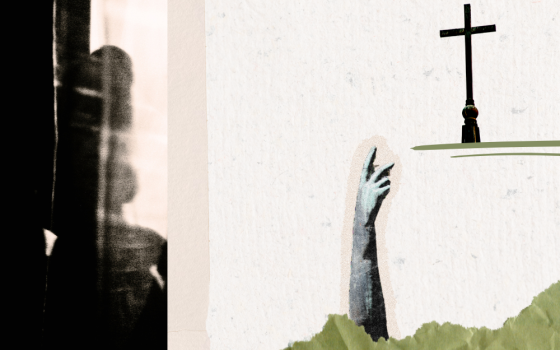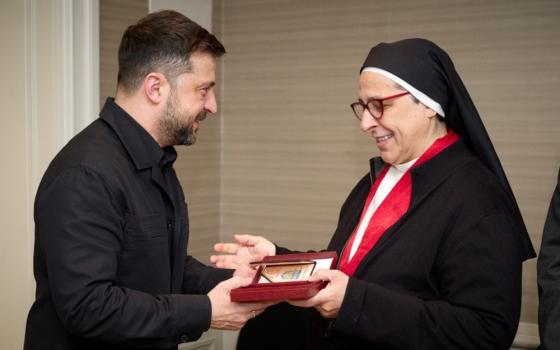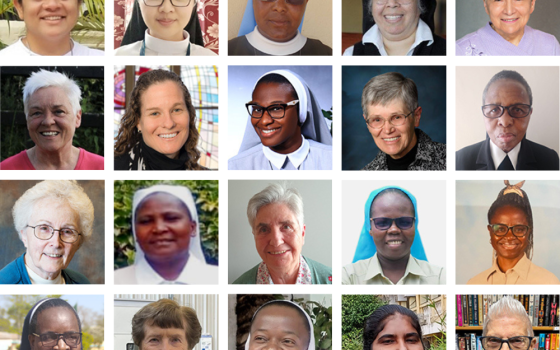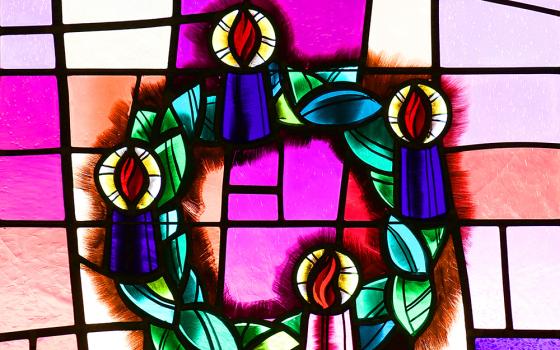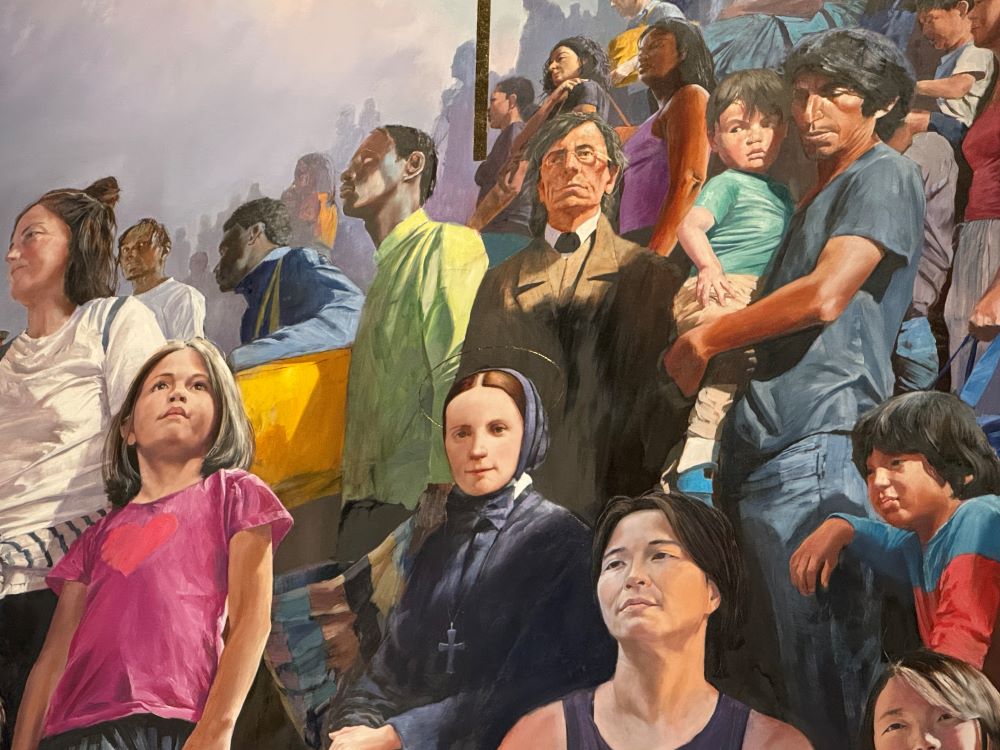
Mother Cabrini, wearing black, is featured in a recently unveiled mural featuring migrants at the entrance of St. Patrick's Cathedral in New York Sept. 23. Mother Cabrini, who immigrated to the United States in 1889, is the patron saint of immigrants. (GSR photo/Rhina Guidos)
In June, after San Diego Bishop Michael Pham accompanied priests and others from his California diocese to immigration court, I read quite a few comments on social media saying something to the effect that finally the church had publicly stepped up to support migrants and refugees. I'm not sure which word hit me harder, "finally," or "the church."
That's because at Global Sisters Report, we regularly publish stories about people in consecrated life, particularly women religious, helping migrants and refugees throughout the Americas. If you sketched the different migration routes from the U.S. to the southern tip of South America, you'd be hard-pressed to find a spot where religious life, particularly sisters, are absent.
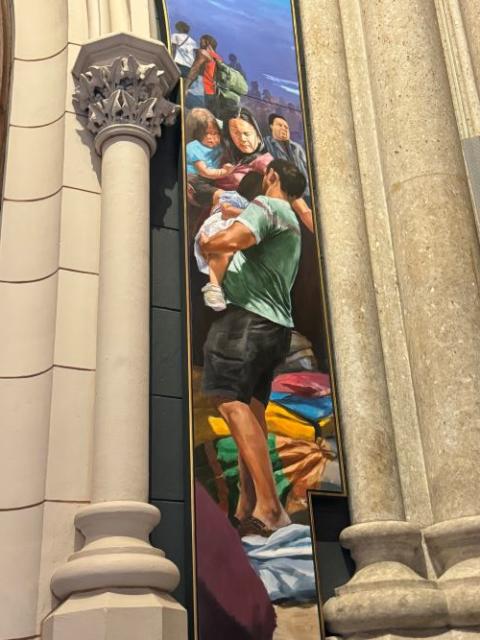
Migrants are featured in a recently unveiled mural at the entrance of St. Patrick's Cathedral in New York Sept. 23. (GSR photo/Rhina Guidos)
It is admirable that Pham, who came to the U.S. as a child and refugee from Vietnam in the early 1980s, took part in World Refugee Day in such a public manner, one that garnered headlines in mainstream news outlets that included National Public Radio and The Washington Post. Washington Auxiliary Bishop Evelio Menjivar, who entered the United States without permission from his native El Salvador, too, has been celebrated for putting his life story out there.
But as we're often reminded, the church is more than its bishops.
Sisters, in the absence of mainstream headlines or media crews following them, toil daily as lawyers in immigration court, raise money for the basics to feed and clothe those passing through or stuck on the other side of the border, and regularly denounce what they see as an unjust immigration system as well the need for the country's clergy to use the pulpit to defend the Gospel's views on migrants.
We write about sisters and their efforts as they, too, like the laity, make up "the church."
Recently, I had the chance to view the newly unveiled mural at the entrance to New York's St. Patrick's Cathedral titled "What's So Funny About Peace, Love and Understanding." It is supposed to depict old and new waves of immigrants to the United States. One side is supposed to represent the Irish arriving via ship, perhaps in the 1800s to 1850s, while the opposite side features a mix of Latino, Asian and other migrants carrying backpacks and children, in what may be the representation of the journey through the Darién Gap, where thousands have perished in their migration journey. Having visited a number of shelters and stopping points where migrants gather on their journeys throughout the Americas, what was missing for me in the mural were sisters buzzing about the crowd.
But then I noticed a figure dressed in black who seemed out of her time period among the newer migrants in the mural, and it took me a minute to realize it depicts Mother Cabrini, who came to the U.S. in the late 1800s from Italy. Back then, Sr. Frances Cabrini founded the Missionary Sisters of the Sacred Heart of Jesus, along with orphanages and schools that helped migrants settle and thrive in their new life in the U.S. She later became a naturalized U.S. citizen and after her 1946 canonization, she became recognized as the patron saint of immigrants.
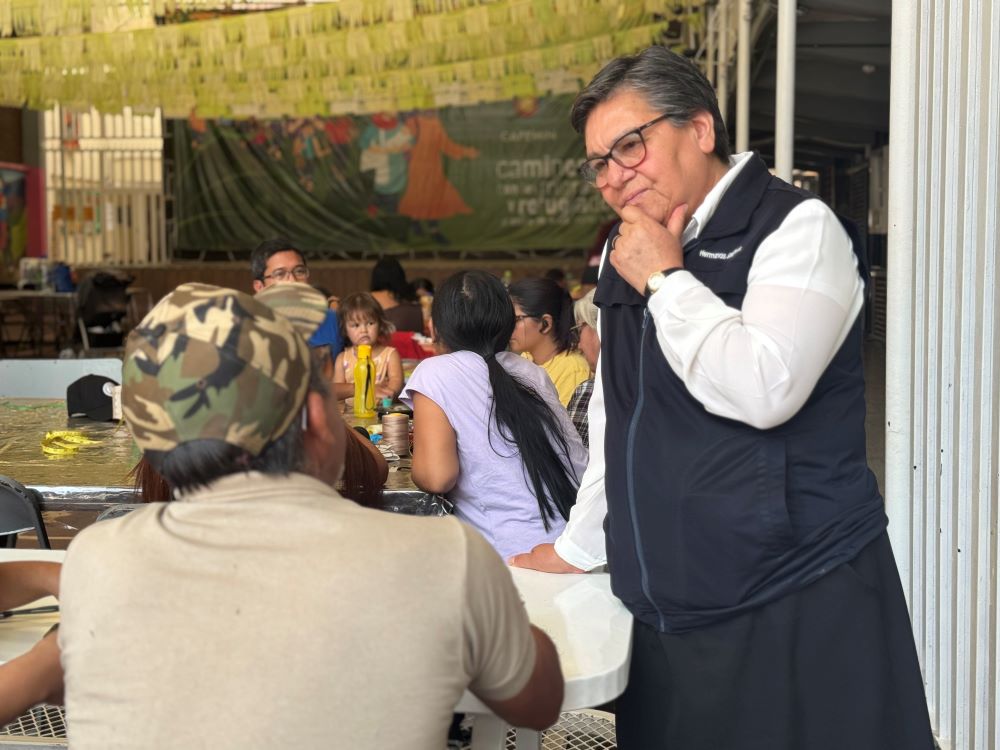
Sr. María Magdalena Silva Rentería listens to a man looking for work April 1 at the CAFEMIN shelter in Mexico City. (GSR photo/Rhina Guidos)
But even before Mother Cabrini's time, sisters had arrived to this nascent country and helped migrants from Europe settle in a new home. And just as people in the United States have opposed and vilified migrants here, sisters like Mother Cabrini never left the side of newcomers.
On World Day of Migrants and Refugees, observed Oct. 4-5 this year, the church celebrates the resilience of people who are displaced. We hope you'll take a look at our coverage to mark the occasion. It reflects the service of women religious like Scalabrinian Sr. Leticia Gutierrez Valderrama, whose invaluable service in immigration courts in El Paso provides comfort but also practical help for those fearing detention and deportation. We also included coverage of sisters who showed up to the streets of Washington to advocate for migrants and who stood with Cardinal Robert McElroy as he called out the government for its unprecedented attacks on the vulnerable population.
In his message to mark the day this year, Pope Leo XIV said that along with celebrating migrants, it also is a time to recognize those who welcome them and with their actions present to the world "a living witness to hope."
Advertisement

